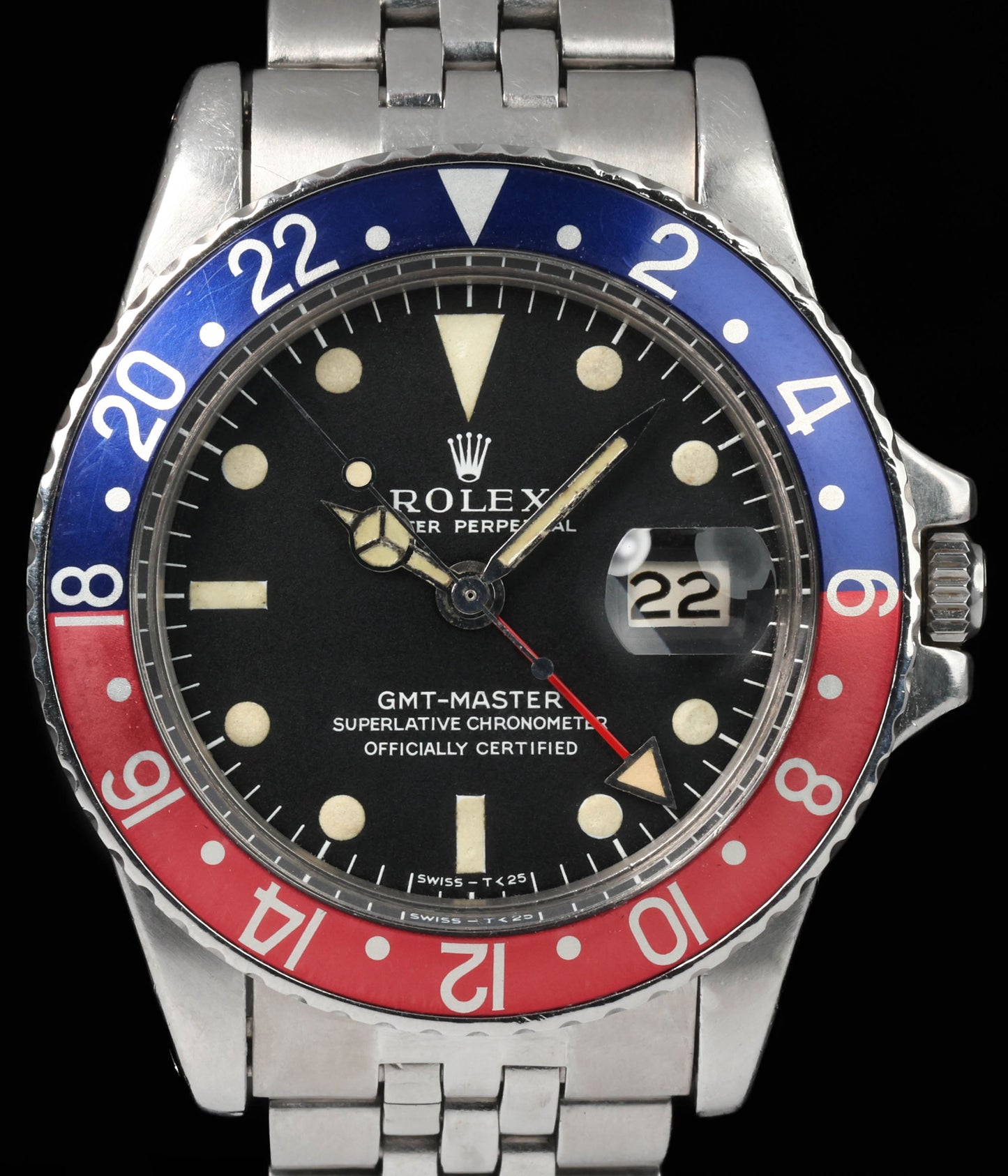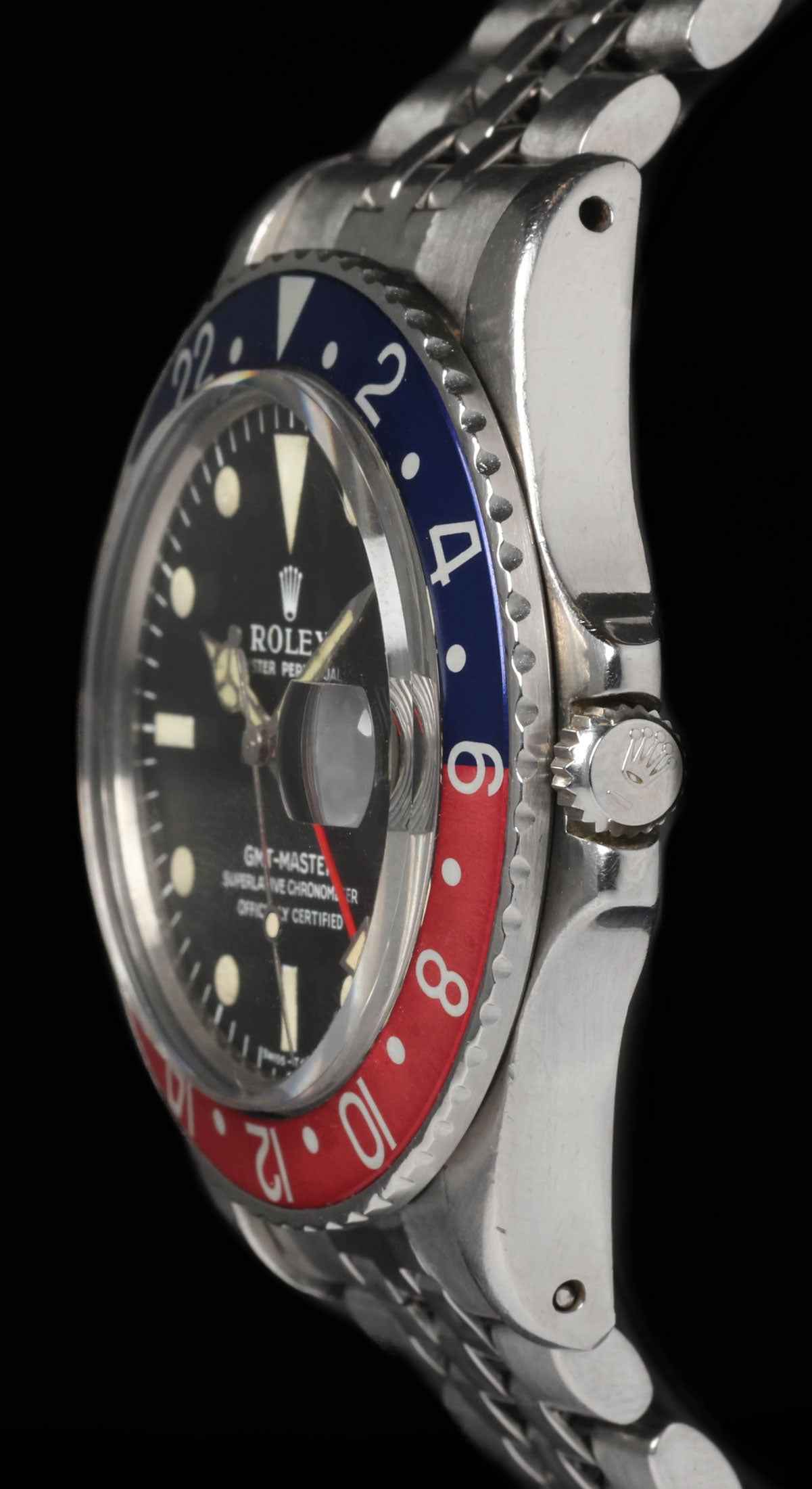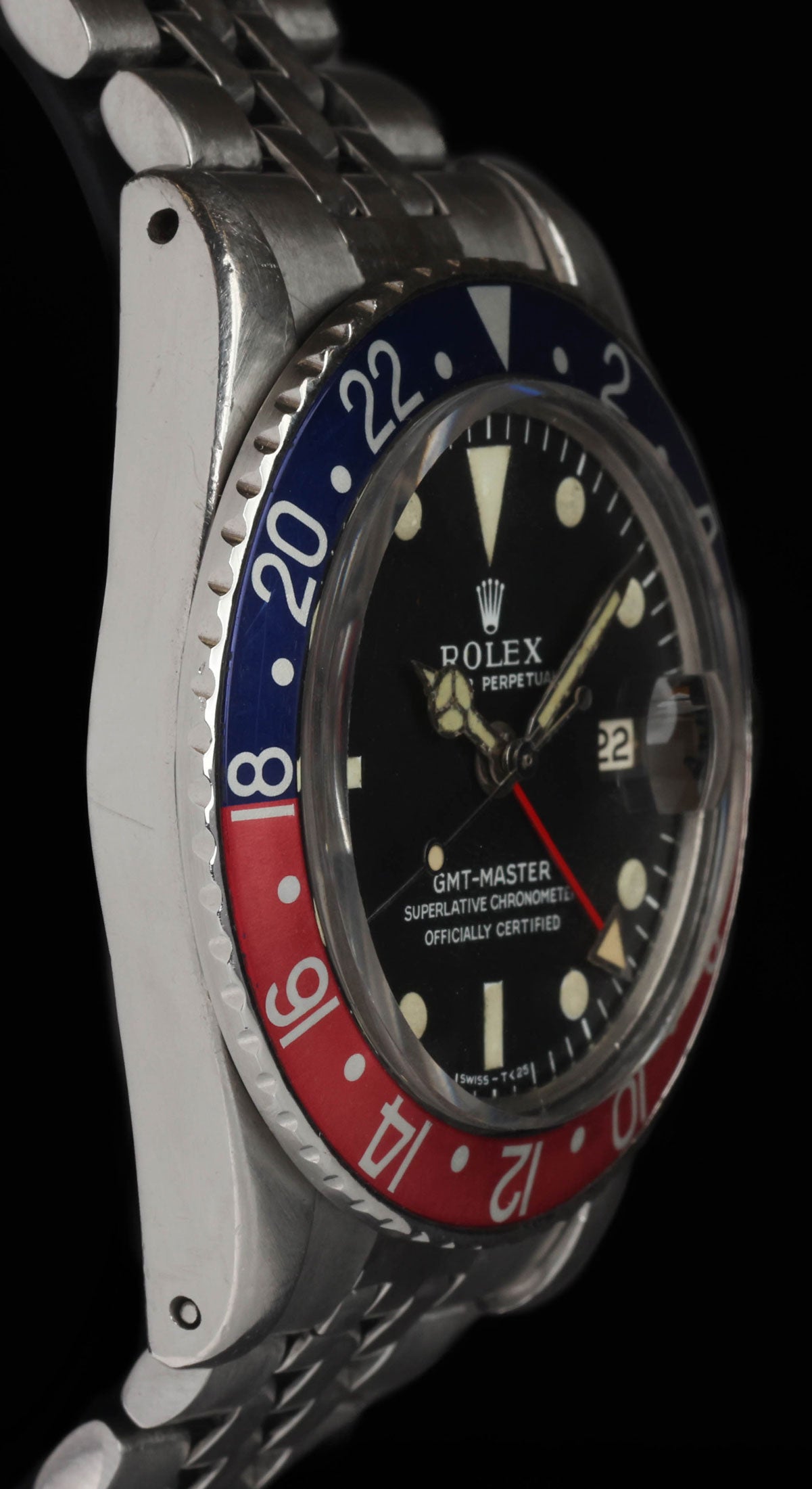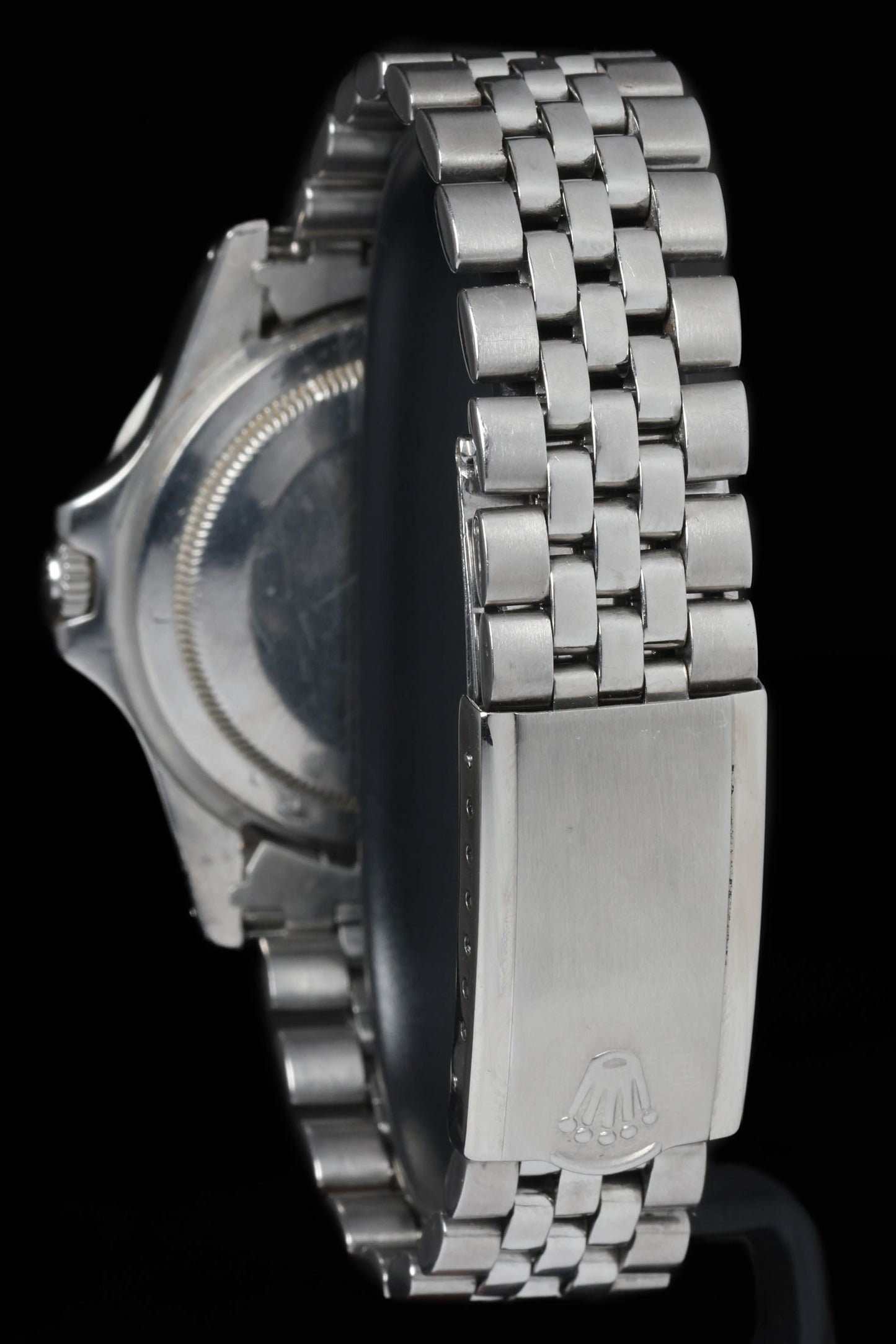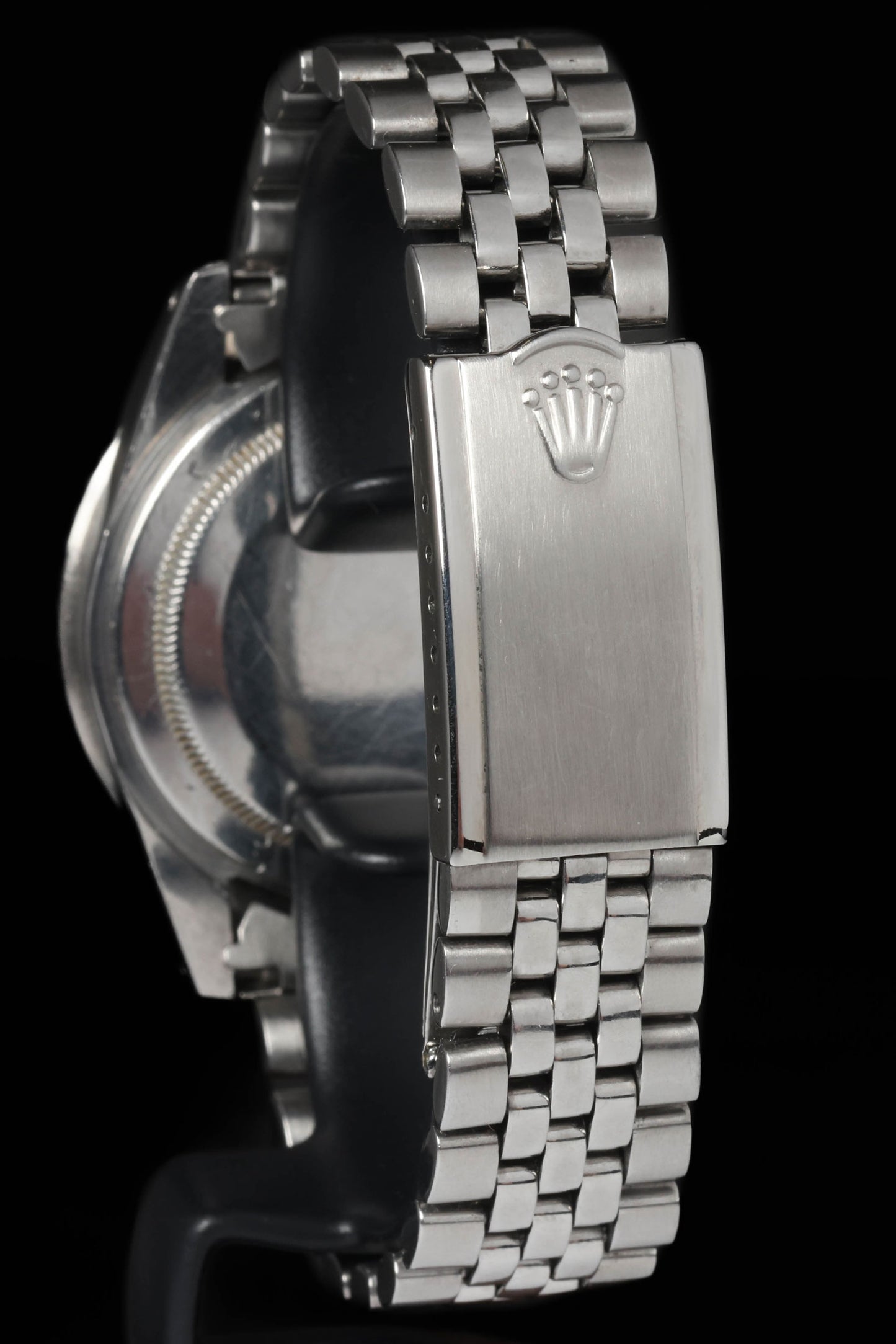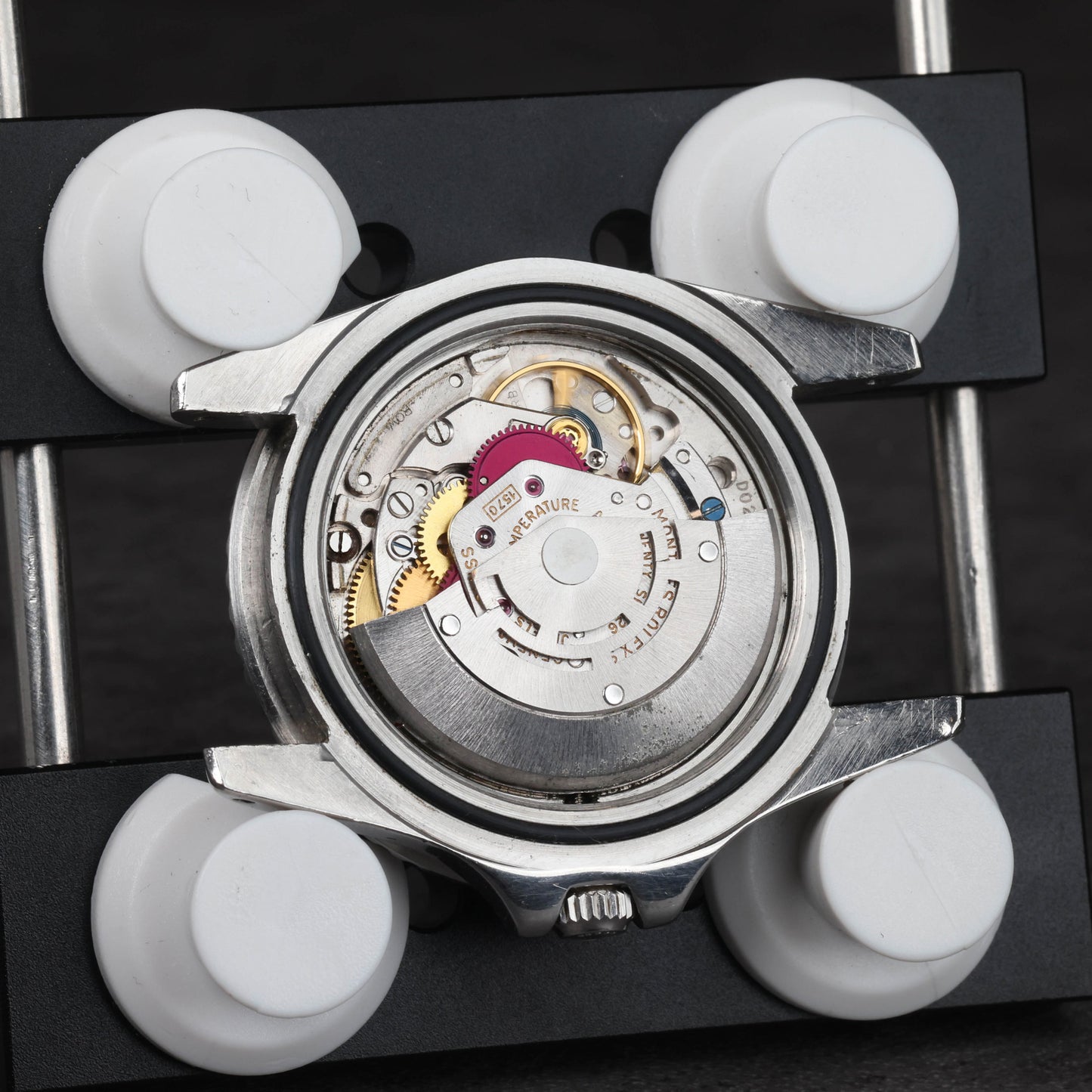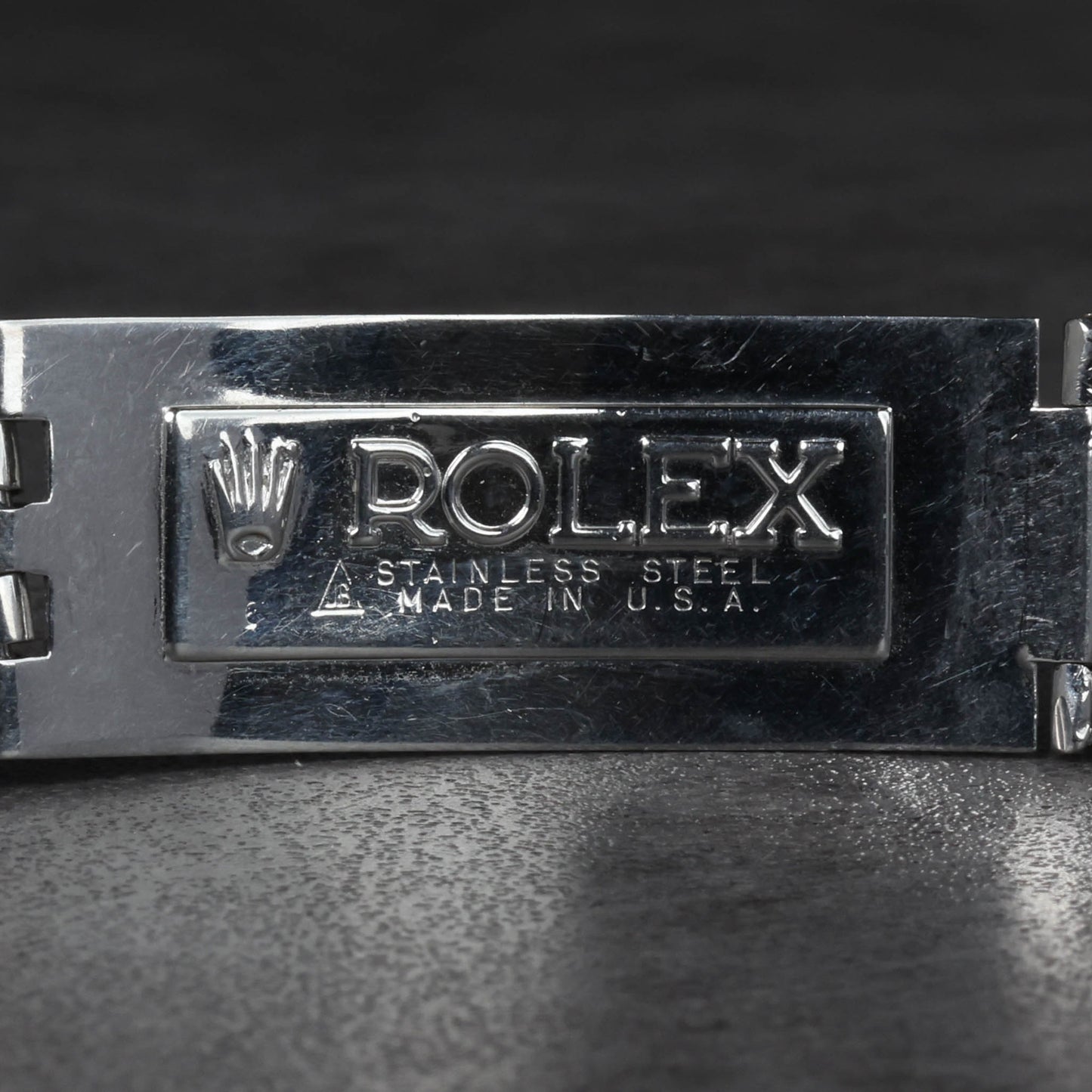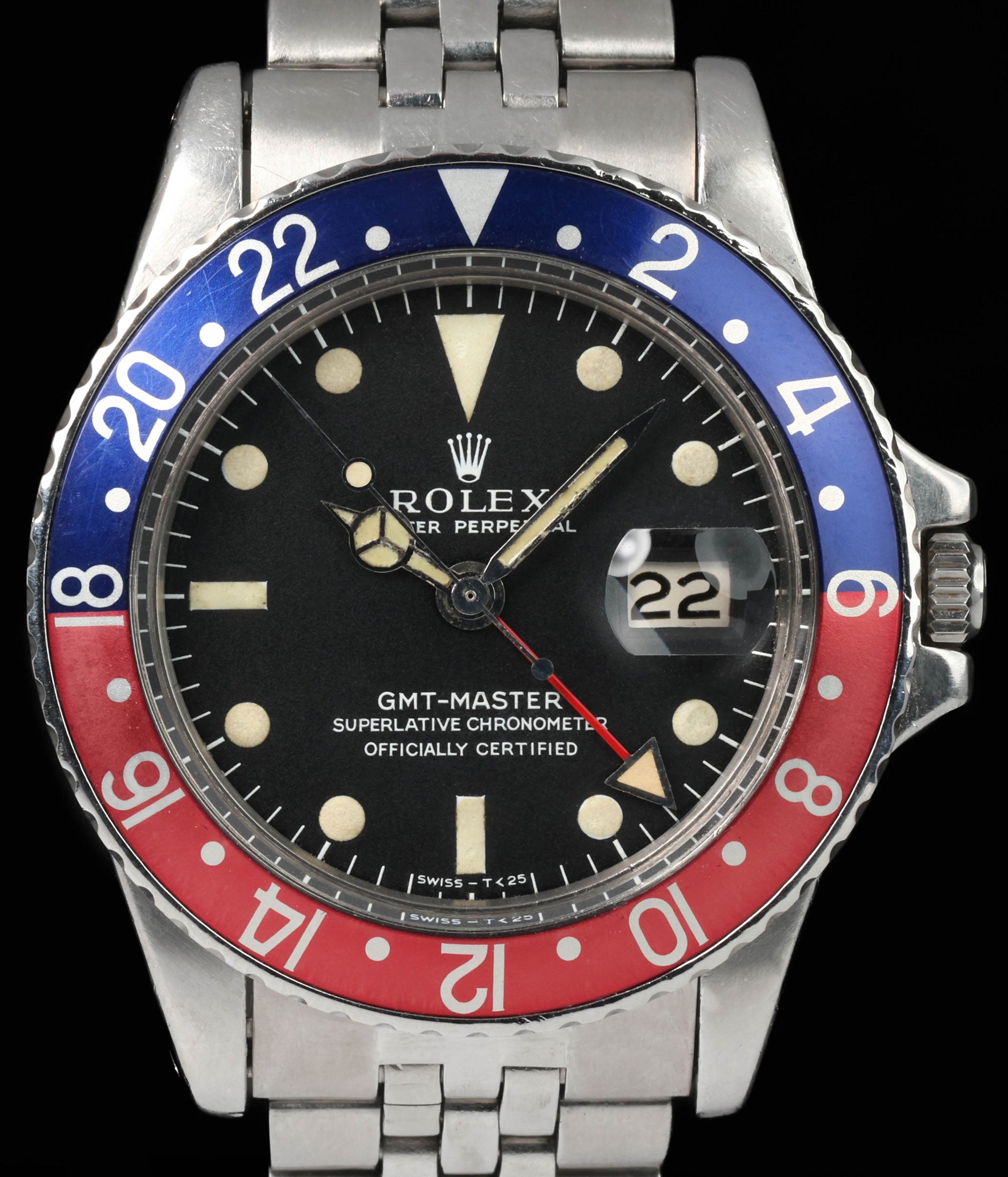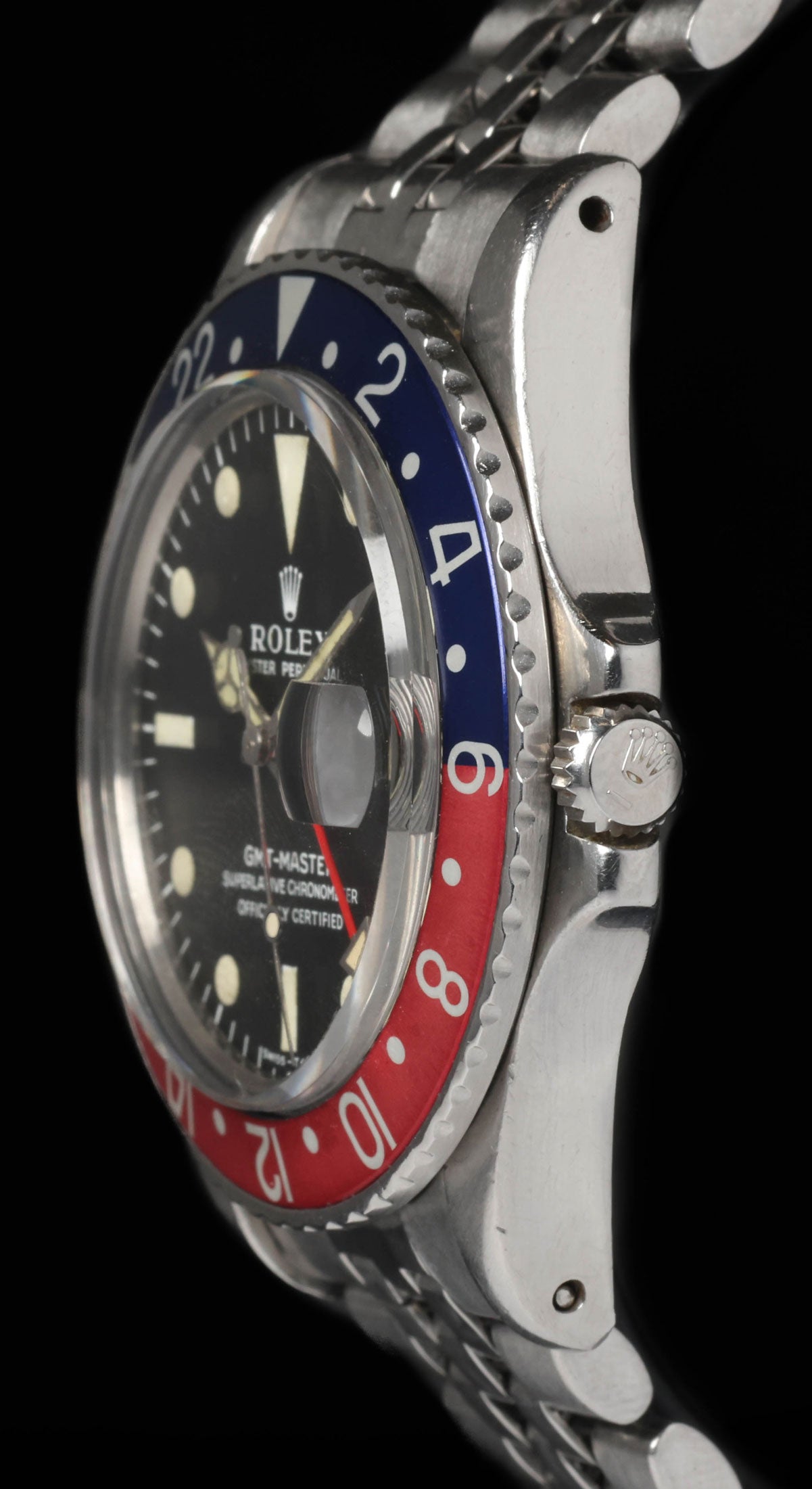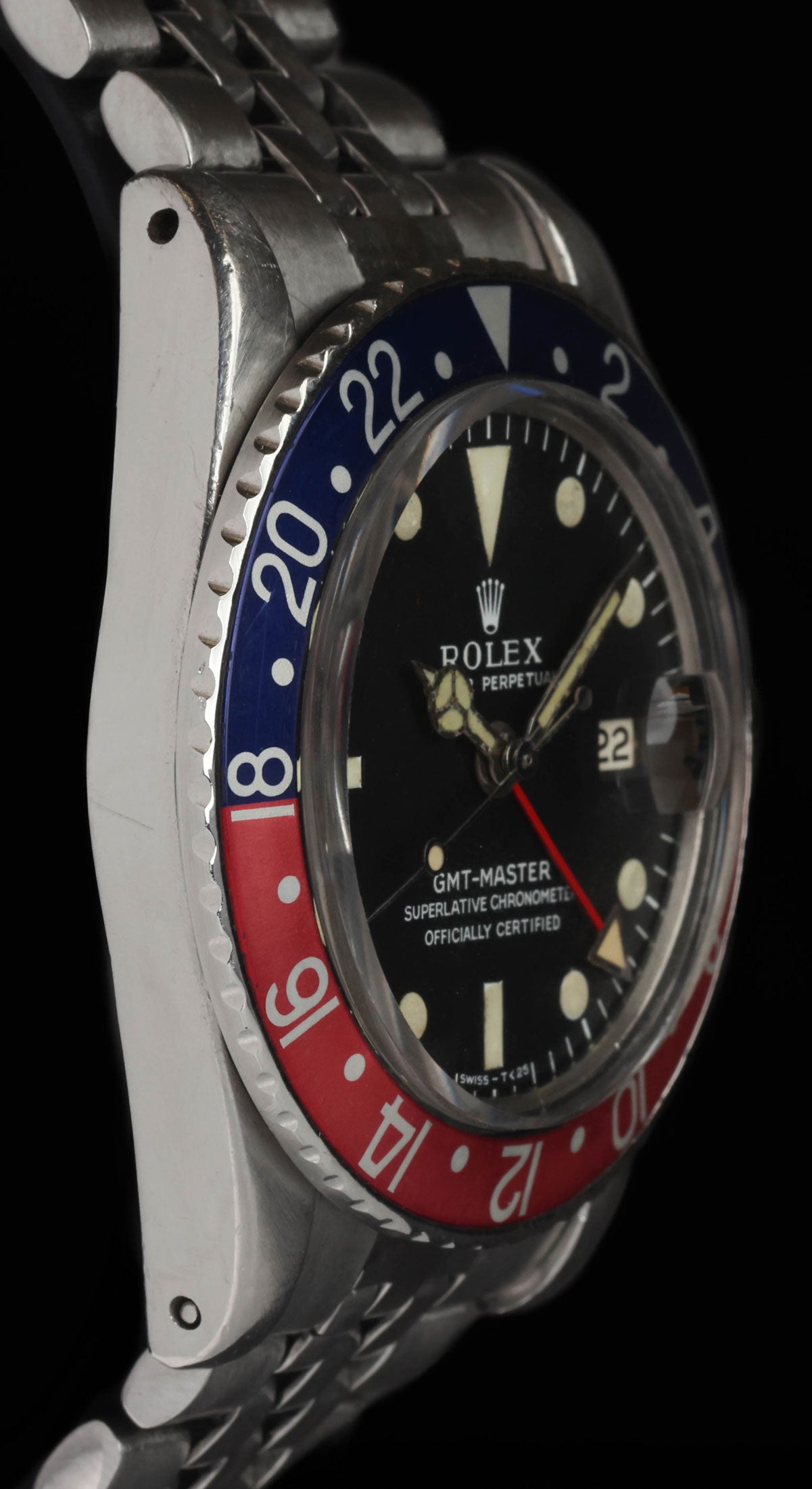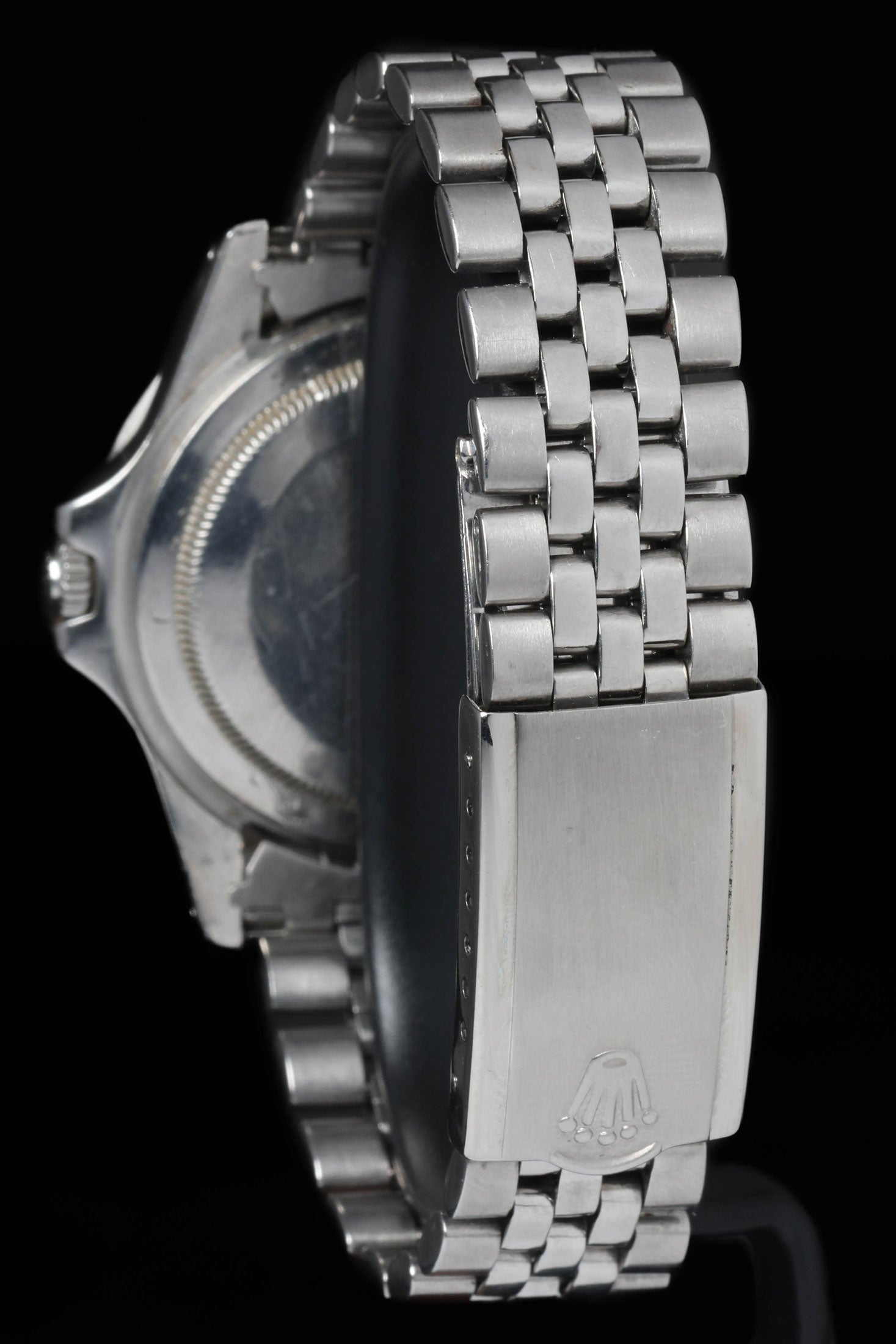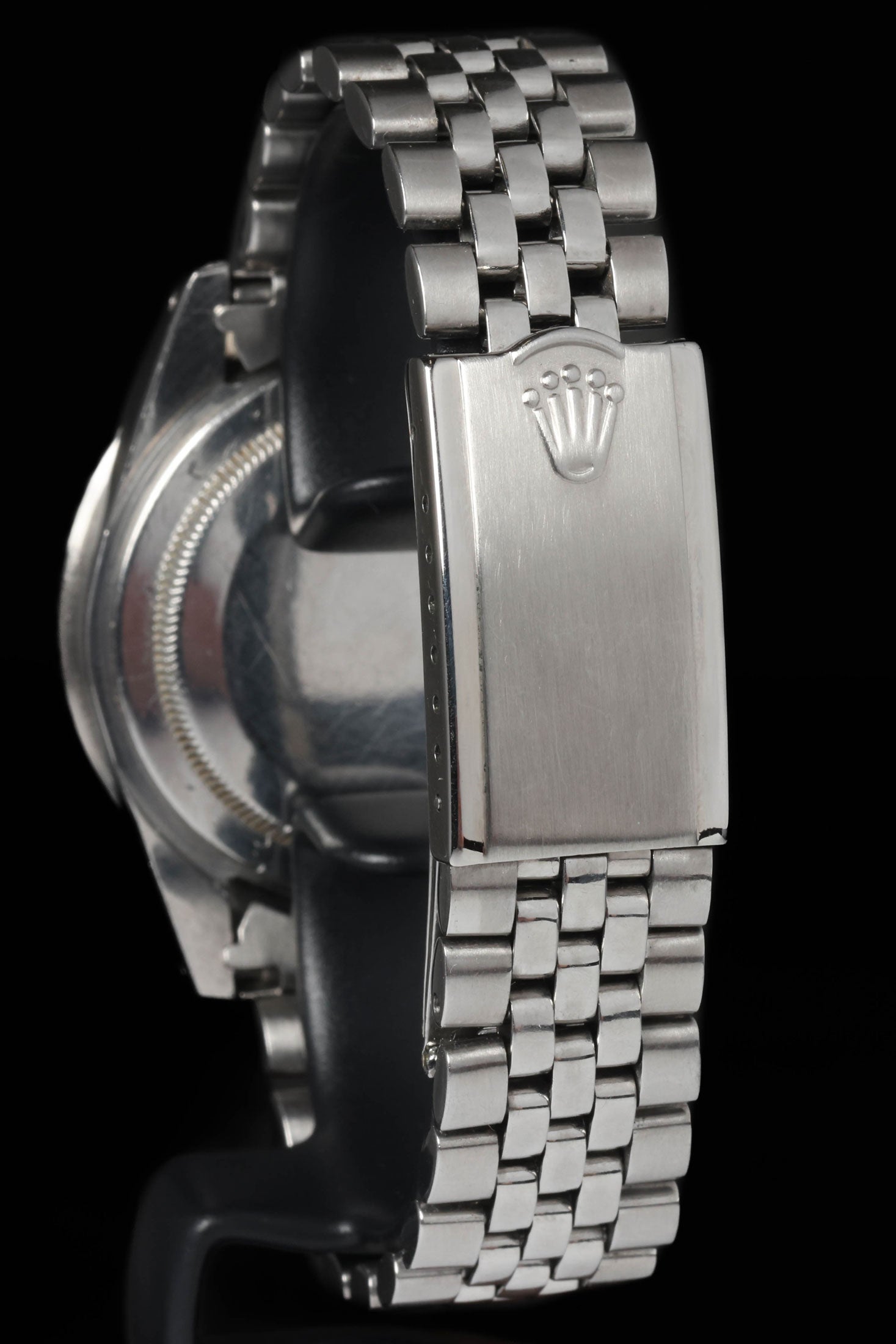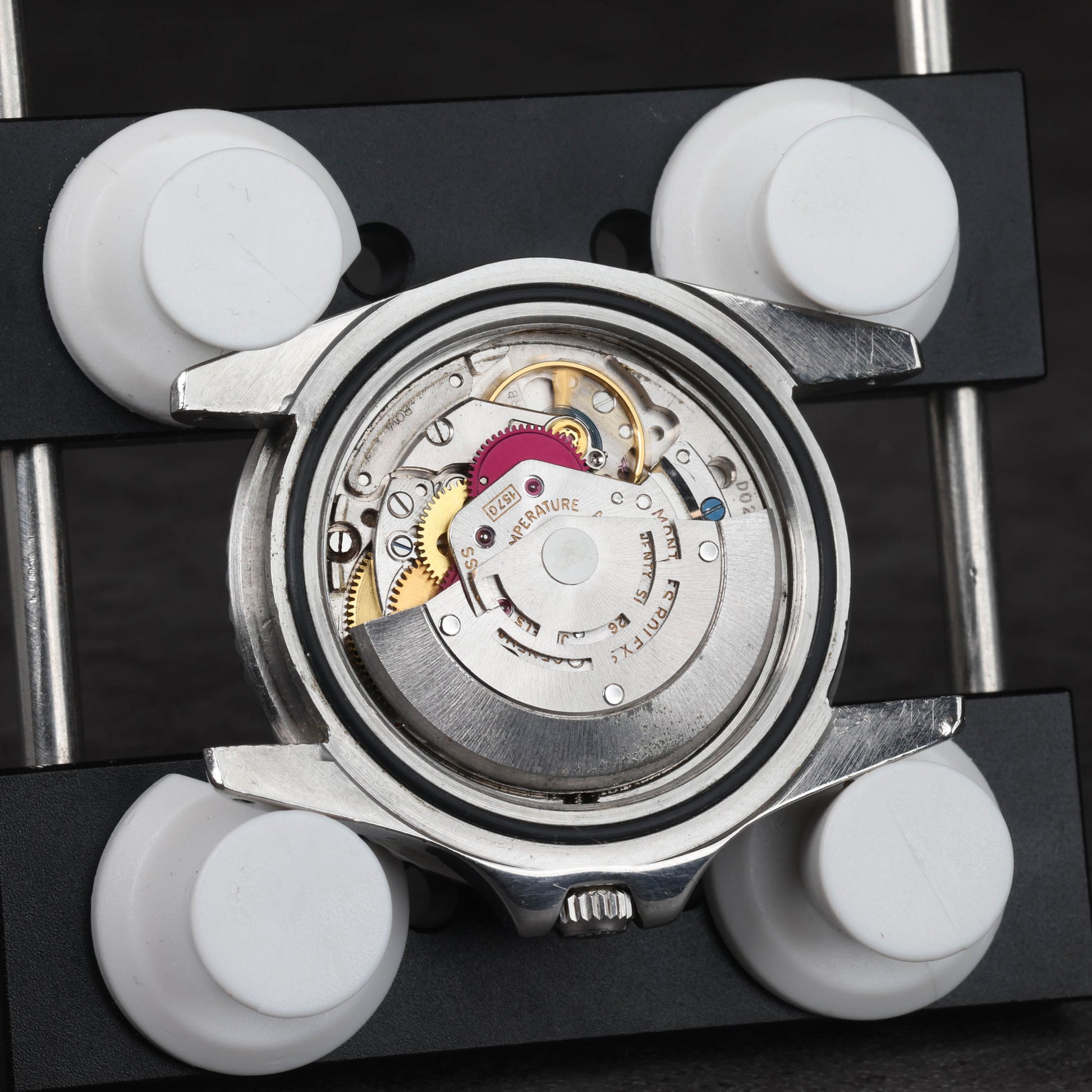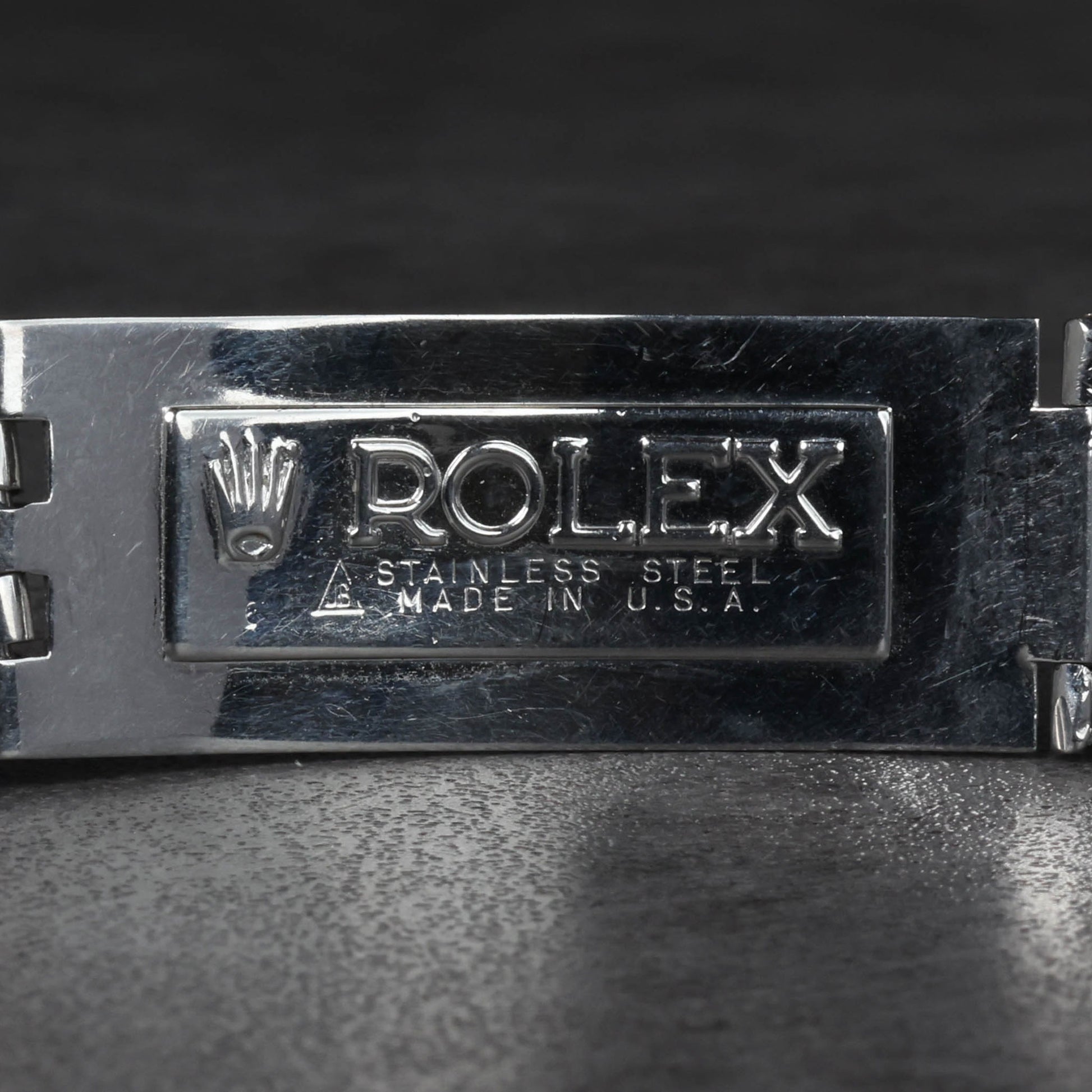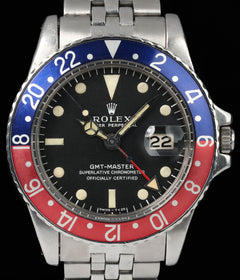Crown Vintage
Rolex GMT Master 1675 MK1 Long-E 'Pepsi' 40MM 1967
Rolex GMT Master 1675 MK1 Long-E 'Pepsi' 40MM 1967
Couldn't load pickup availability
Rolex GMT Master 1675 Long-E 'Pepsi'
Good vintage condition with hairlines and scratches visible on both flanks and lugs; wear consistent with age. The case retains honest geometry with no signs of excessive refinishing.
Bracelet: Rolex 6215 folded Jubilee with visible stretch; rare “Made in USA” variant. Clasp and links operate as expected.
Dial & Hands: Dial in great condition with an even matte surface; lume plots are puffy and well-preserved. Hands show oxidation with a uniform, pleasing patina that aligns with the dial.
Lume/UV: Dial and hands use zinc sulphide and tritium. Lume is inactive in normal light but responds under UV blacklight as expected for tritium of this era.
This is a vintage timepiece. Do not wear it while swimming or expose it to water.
Share
Why we love this watch
Why we love this watch
Rolex GMT-Master 1675 “Long-E” Pepsi: Jet-Age Utility with Typographic Character
Introduction
The Rolex GMT-Master 1675 “Long-E” pairs the most recognisable travel-watch silhouette—red/blue 24-hour bezel, Cyclops date, and a fourth hand for a second time zone—with a dial that specialists instantly spot: the elongated centre bar of the “E” in ROLEX. That small typographic quirk signals the first matte-dial generation after the glossy gilt era and anchors this configuration within a short, influential chapter of the model’s evolution. What you get is classic Oyster ergonomics, true dual-time function, and a face that reads cleanly in any light, framed by the aluminium “Pepsi” insert that made the GMT-Master a fixture of airports and airframes alike.
GMT-Master History: From Pan Am Brief to Global Icon
Rolex created the GMT-Master in the 1950s in response to the newly jet-powered world of long-haul routes. Pilots needed a wrist-borne way to track home time while flying across rapid time-zone changes. Reference 6542 launched the concept with a bi-directional 24-hour bezel and a dedicated 24-hour hand geared to the movement. It had no crown guards and wore a fragile Bakelite insert that looked spectacular but struggled in service. The 1675 followed with the Oyster case’s next leap: crown guards for protection, a more robust aluminium bezel insert, and the practical Cyclops over the date. Through the 1960s the model shifted from glossy gilt dials with radium to safer tritium and, crucially, to matte black dials with white printing for lower glare in the cockpit. The “Long-E” sits right at that transition. It retains the essential language—the 24-hour hand, the two-tone day/night bezel, the broad minute track—but updates the dial surface and typography for the next era of use.
Why the 1675 Was the Right Platform
The 1675 kept the dimensions wearable and the function intuitive. A fourth hand geared to 24 hours pointed to the bezel scale so a glance told you home time, while the standard hands covered local hours and minutes. By rotating the bezel you could align to another offset and read a third zone. This flexibility is why the watch bridged aviation, business travel and daily life without complication creep.
Where the “Long-E” Fits: The First Matte-Dial Phase
“Long-E” is shorthand for a specific dial family whose tell is the extended centre bar of the “E” in ROLEX—long enough to sit visually centred between the top and bottom arms. It appears on early matte dials that replaced the preceding glossy gilt faces. You’ll typically see crisp white printing on a charcoal-black, non-reflective ground, wide open minute/seconds hashes, and the tritium notation at six (“SWISS-T<25” or close variants). There’s no chapter ring encircling the minute track—another hallmark of the matte shift. In person, the difference is immediate: the matte surface kills cockpit glare, the white text pops, and the hour plots read at a glance. The typographic change is subtle but distinctive; it marks the model’s move from mid-century shine to a more instrument-first presentation without disturbing the core layout.
Dial Furniture and Period Details
Applied surrounds were not yet standard on this phase; lume plots sit cleanly within printed frames. Fonts on the depth and model lines are even-weighted and measured. The coronet is slender, the spacing tidy, and the “ROLEX” wordmark balances the dial so that the red 24-hour hand and the “Pepsi” ring remain the colour accents.
Case and Bezel: Proportions That Wear Anywhere
The GMT-Master 1675 case sits at about 40 mm with 20 mm lugs and the slim, rounded crown guards that define the reference. Lug holes make strap changes easy; brushing on the lugs meets polished case flanks with clean transitions; and the overall height remains low thanks to the domed acrylic crystal. The bezel is bi-directional, coin-edged for grip, and fitted with an aluminium insert that splits red and blue at the 6/18 markers to indicate night/day on the 24-hour scale. Aluminium’s softer sheen keeps reflections controlled and ages with character—ranging from bright two-tone to softly faded “raspberry/navy” depending on exposure.
Pepsi Insert: Function First, Colour Second
The blue half covers 18:00–06:00 (night), the red half 06:00–18:00 (day). That split isn’t just iconic; it’s a quick cognitive cue in low light and at a glance. Numerals are evenly weighted, triangles and hashes are readable from shallow angles, and the pip at zero is filled with luminous compound for orientation.
Movement and Time-Zone Logic
The 1675 of this phase runs a Rolex workhorse automatic: calibre 1575 (preceded by 1565 in earlier years). Beating at a steady rate and built around a bidirectional rotor, it drives the standard hands plus a 24-hour wheel geared to the extra hand. There’s no independent jump hour yet—that arrives in later generations—so the practical method is simple and effective: set the 24-hour hand to home time, set the main hands to local, and use the bezel for a third offset when needed. It’s intuitive and robust, with fewer moving parts than later dual-setting systems.
Hacking, Winding and Crown Feel
Examples from this period generally pre-date hacking seconds; hand-setting is precise, the crown action is solid, and the screw-down interface preserves the Oyster’s water-resistant integrity for everyday use. The aim here isn’t complication for its own sake—it’s dependable, repeatable time-zone utility.
Crystal, Date and Legibility
A domed acrylic crystal provides gentle edge distortion that brings the minute track to life at angles. The Cyclops magnifier at three makes the date immediate, and the silver date disc with period-correct typography sits deep under the dome for a warm, dimensional read. Acrylic’s great trick is glare control: it softens harsh reflections under fluorescents or midday sun, which aligns nicely with the matte dial’s mission.
Hands and Lume
The handset is the classic trio—Mercedes hour, long minute baton, lollipop seconds—joined by a red 24-hour hand. In this window you’ll commonly see the earlier, smaller triangular tip on that red hand; slightly larger arrows appear later. Luminous compound is tritium, so the glow is soft and brief after charge but the daytime tone can mellow to a pleasing cream—part of the charm of this configuration.
Bracelet Options and Wearing Character
The 1675 accepts both Oyster and Jubilee bracelets. Period-correct Oyster options include riveted references that keep weight down and articulation high; Jubilee adds an easy drape and a touch of sparkle against the tool-leaning case. Either way, the lug span and case curvature keep the head centred so the watch wears planted, not top-heavy. The overall impression is light, agile and unpretentious—designed to be used, not tucked away.
Why It Sits So Well
Short lugs, a slim mid-case, and that acrylic dome keep the visual mass low. The bezel’s narrow wall ensures the dial dominates at a glance, and the bi-directional action is positive without being stiff, so timing offsets becomes second nature.
The Long-E Dial Explained: What to Look For
Spotting a Long-E is straightforward once you know the cue. Look at “ROLEX”: the middle bar of the “E” stretches nearly the full width between the top and bottom arms, giving the letter a balanced, elongated look—hence the name. The wordmark sits proportionately under a slender coronet with consistent spacing, and the rest of the text—“OYSTER PERPETUAL” and “GMT-MASTER”—is printed in a fine, even weight that suits the matte ground. At six, the tritium line is present (“SWISS-T<25” or “T SWISS T<25”), and the minute track is continuous without a chapter ring. Together these traits place the dial at the beginning of the matte era, immediately following the gilt/gloss generation.
Using the GMT-Master: Real-World Time-Zone Scenarios
Set the red 24-hour hand to home time, reading against the fixed twelve o’clock triangle. Local time runs on the standard hands. Need a third zone? Rotate the bezel so the new offset aligns with the triangle, then read home against the bezel and the third zone against the 24-hour hand’s new index. It’s fast, requires no crown work, and avoids the wear of constant hand-moving. This is why the watch moved from cockpits to terminals to desks without losing relevance: it’s a mechanical solution that stays simple under pressure.
Why the “Pepsi” GMT-Master Endures
Part of the appeal is the clarity of purpose. The two-colour 24-hour ring is not decoration; it’s a day/night cue that speeds up brainwork when you’re tired or jet-lagged. The fourth hand eliminates mental arithmetic for home time. The matte dial and acrylic crystal keep reflections in check. And the Oyster case wraps it all in a compact, durable shell that handles real-world knocks. Add the Long-E’s typographic signature and you have a reference that is instantly recognisable yet quietly specific within the lineage.
Aluminium and Acrylic in Context
Modern ceramics and sapphire are tough and brilliant, but aluminium and acrylic have virtues aligned with travel: they’re light, they avoid mirror-glare, and when they pick up surface marks they can be refreshed without drama. On a watch meant to be used between terminals and taxis, those traits still make sense.
How It Wears Today
On an Oyster bracelet, the watch reads confident and uncluttered. On a Jubilee, it leans more relaxed without losing function. Swap to a woven strap for a weekend itinerary and the 20 mm lug width accommodates it—and the drilled lug holes make the change simple. The head stays centred, the bezel invites interaction, and the matte dial remains legible in any lighting you throw at it.
Final Thoughts
The Rolex GMT-Master 1675 “Long-E” distils what makes this travel watch enduring: a clean dual-time solution, a two-colour bezel that turns day/night into instinct, and an Oyster case that wears with ease from cab to cabin. The first matte-dial phase delivers a low-glare, high-contrast face, and the elongated “E” signature ties the configuration to a brief, meaningful step in the model’s development. Nothing here is superfluous; everything earns its keep. If the goal is a mechanically simple, instantly readable, and quietly distinctive GMT-Master, the Long-E Pepsi nails the brief.
Case & Bracelet
Case & Bracelet
- Case in good vintage condition. Hairlines and scratches visible around both sides of the case. Consistent wear expected for a nearly 60 year old watch.
- Bracelet 6215 Folded jubilee, stretch visible. Rare Made in USA variant.
Dial & Hands
Dial & Hands
- Dial in great condition, very nice matte texture & puffy lume.
- Hands oxidised with a nice patina.
- Dial & hands use Zinc sulfide & tritium (still glows under UV blacklight).
Warranty & Condition
Warranty & Condition
Crown Vintage Watches provides a minimum 3-month mechanical warranty on pre-owned watches, from the date of purchase.
The warranty covers mechanical defects only.
The warranty does not cover damages such as scratches, finish, crystals, glass, straps (leather, fabric or rubber damage due to wear and tear), damage resulting from wear under conditions exceeding the watch manufacturer’s water resistance limitations, and damage due to physical and or accidental abuse.
Please note, water resistance is neither tested nor guaranteed.
Shipping and insurance costs for warranty returns to us must be covered by the customer. Returns must be shipped via traceable courier. Return shipment must be pre-paid and fully insured. Collect shipping will be refused. In case of loss or damages, the customer is liable.
Our Pledge
At Crown Vintage Watches, we stand by the authenticity of every product we sell. For added peace of mind, customers are welcome to have items independently authenticated at their own expense.
Condition
Due to the nature of vintage timepieces, all watches are sold as is. We will accurately describe the current condition and working order of all watches we sell to the best of our ability.
Shipping & Refund
Shipping & Refund
